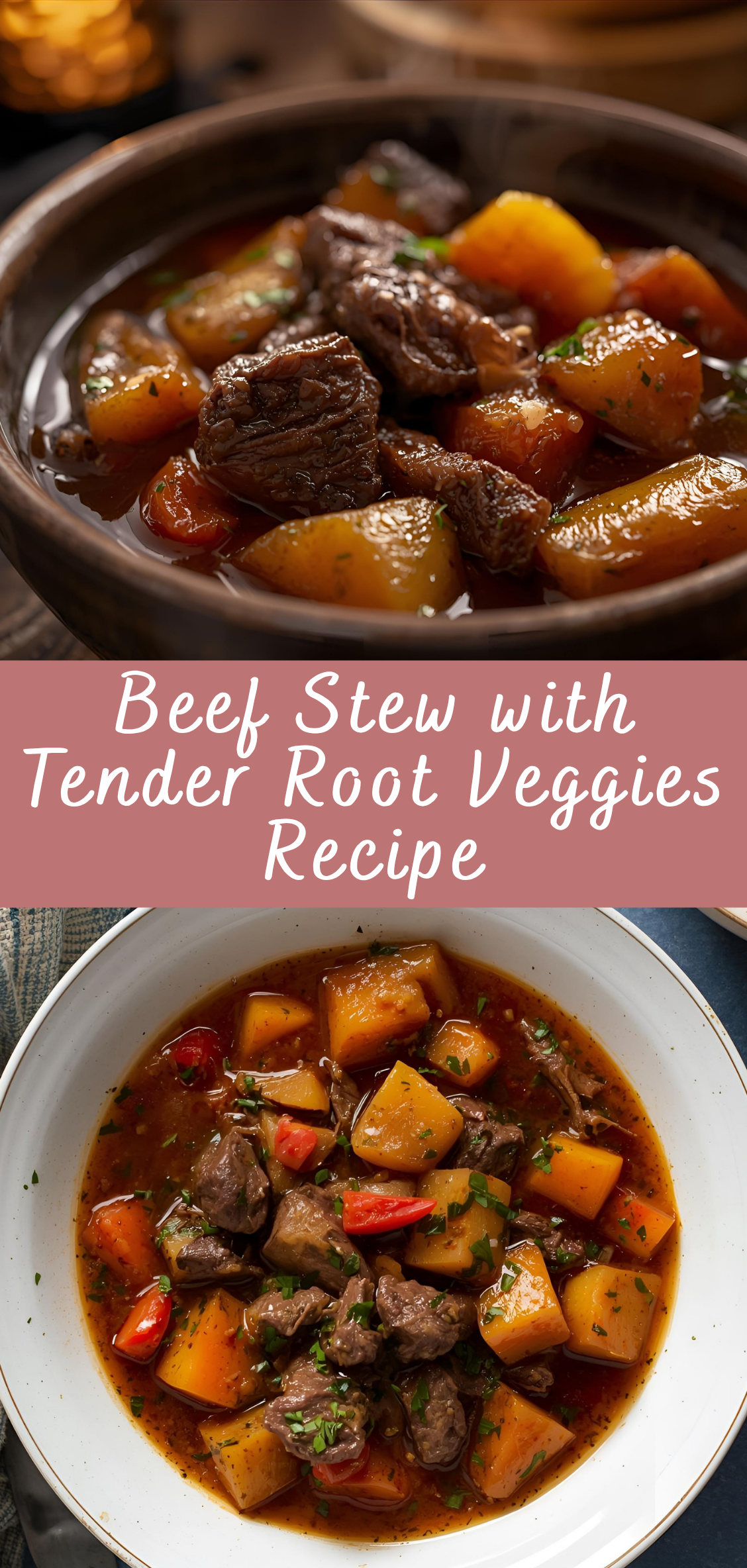Hearty Beef Stew with Tender Root Vegetables: A Slow-Cooked Classic for Every Season
Few dishes capture the essence of comfort and tradition quite like a well-made beef stew. With its deep, savory broth, melt-in-your-mouth beef, and an array of tender root vegetables, beef stew is more than just a meal—it’s a symbol of home, warmth, and nourishment. Whether ladled into bowls on a crisp autumn evening or simmered slowly on a cold winter Sunday, this timeless dish brings people together in a way that only truly hearty food can.

At its core, beef stew is a simple concept: affordable cuts of meat, slow-cooked with vegetables in a flavorful liquid until everything is irresistibly tender. But simplicity doesn’t mean a lack of depth. In fact, the magic of beef stew lies in the layering of flavor, texture, and technique. From the initial browning of the beef to the slow melding of herbs and aromatics, every step adds nuance to the final bowl.
Root vegetables like carrots, parsnips, turnips, and potatoes not only enhance the heartiness of the stew but also bring a natural sweetness and earthiness that balances the richness of the beef. As they simmer gently, these vegetables absorb the meaty broth, becoming soft, flavorful gems that make each bite deeply satisfying.
This guide is much more than a basic recipe—it’s a full exploration of what makes an unforgettable beef stew. Whether you’re a seasoned home cook looking to refine your technique or a beginner learning how to build flavor from scratch, this article will walk you through every step. From selecting the right cut of beef to choosing the best vegetable combinations, from classic slow-cooker methods to Dutch oven mastery, you’ll find everything you need to create a stew that’s rich, comforting, and full of soul.
Section 1: Ingredients – Building a Flavorful Foundation
To make an unforgettable beef stew, the quality and preparation of your ingredients matter. From selecting the right cut of beef to choosing the perfect medley of root vegetables, every choice contributes to the depth of flavor and texture in the final dish.
Core Ingredients
For the Beef and Browning:
-
2.5 to 3 pounds beef chuck roast (well-marbled, trimmed and cut into 1.5-inch cubes)
-
2 tablespoons vegetable oil or olive oil (for browning)
-
Kosher salt and freshly ground black pepper (to season the beef)
For the Aromatics and Base:
-
1 large yellow onion, chopped
-
4 garlic cloves, minced
-
2 tablespoons tomato paste
-
2 tablespoons all-purpose flour (for thickening)
-
¾ cup dry red wine (optional but recommended)
-
4 cups beef stock or broth (preferably low-sodium)
-
1 tablespoon Worcestershire sauce
-
1 teaspoon soy sauce (optional, adds umami)
For the Root Vegetables:
-
4 large carrots, peeled and cut into thick chunks
-
3 medium parsnips, peeled and chopped
-
2 medium turnips, peeled and cubed
-
2 medium Yukon gold or red potatoes, cut into large chunks
-
2 stalks celery, chopped (optional for added aromatics)
Herbs and Seasoning:
-
2 bay leaves
-
1 teaspoon dried thyme or 1 tablespoon fresh thyme
-
1 sprig rosemary or ½ teaspoon dried rosemary
-
Fresh parsley (chopped, for garnish)
Optional Add-Ins:
-
1 cup chopped mushrooms for an earthy depth
-
1 teaspoon smoked paprika for a subtle smoky flavor
-
A pinch of crushed red pepper flakes for gentle heat
Section 2: Prepping the Ingredients – Mise en Place Matters
Preparing all your ingredients before cooking (a technique known as mise en place) not only makes the cooking process smoother but also prevents mistakes, like overcooking the beef or forgetting a key seasoning.
Step 1: Cut the Beef
-
Use a sharp knife to cut the beef chuck into 1½-inch cubes. Avoid small pieces—they can overcook and dry out.
-
Trim away large pieces of hard fat, but leave some marbling for tenderness and flavor.
-
Pat the beef dry with paper towels before seasoning. Moisture on the surface will prevent browning.
Step 2: Peel and Chop the Vegetables
-
Cut carrots, parsnips, turnips, and potatoes into large chunks — they’ll shrink and soften during the long cook.
-
Aim for uniform sizes to ensure even cooking.
-
Store chopped root vegetables in a bowl of cold water if not using immediately (especially potatoes) to prevent discoloration.
Section 3: Browning the Beef – Developing Deep Flavor
One of the most important steps in stew-making is searing the meat. This builds a rich, caramelized flavor base that enhances the stew far beyond what boiling or slow-cooking alone can achieve.
Step 3: Sear the Beef in Batches
-
Heat 1 tablespoon of oil in a heavy-bottomed Dutch oven or large pot over medium-high heat.
-
Working in batches, sear the beef cubes on at least two sides, about 2–3 minutes per side, until they develop a deep brown crust.
-
Avoid overcrowding the pot—this causes the beef to steam rather than brown.
-
Transfer the seared beef to a plate and set aside.
Tip: Don’t rush this step. Take your time to let each batch brown properly. Those browned bits (fond) left in the pot will dissolve later, adding immense flavor.
Section 4: Building the Stew Base – Aromatics and Liquids
After the beef is seared, it’s time to create the aromatic and liquid base that will carry flavor through the stew.
Step 4: Sauté Aromatics
-
In the same pot (with fond intact), reduce heat to medium.
-
Add chopped onions and cook for 4–5 minutes until soft and lightly golden.
-
Stir in garlic and cook for 1 minute until fragrant.
Step 5: Add Tomato Paste and Flour
-
Add tomato paste and stir continuously for 2–3 minutes. This deepens the flavor and removes the raw taste.
-
Sprinkle in the flour and stir well to coat the onions. This will help thicken the stew later.
Note: You’re cooking the flour here so it won’t taste pasty in the final dish. It should form a reddish-brown paste.
Step 6: Deglaze with Wine (Optional)
-
Pour in the red wine and use a wooden spoon to scrape up all the brown bits from the bottom of the pot.
-
Let the wine simmer for 5–6 minutes until it reduces by half.
Substitute: If you don’t use wine, add an extra ½ cup of beef stock and a teaspoon of balsamic vinegar or lemon juice to mimic the acidity.
Section 5: Simmering and Layering the Stew
Step 7: Add Beef and Liquids
-
Return the seared beef and any juices to the pot.
-
Add the beef stock, Worcestershire sauce, soy sauce (if using), thyme, rosemary, and bay leaves.
-
Stir well to combine.
Tip: The liquid should just cover the beef. If not, add a bit more stock or water.
Step 8: Simmer Gently
-
Bring the stew to a gentle simmer over medium heat.
-
Once simmering, reduce heat to low, cover, and let cook for 1½ to 2 hours, stirring occasionally.
-
After the first hour, check the beef. It should be starting to soften but not yet fall apart.
Alternative Cooking Methods:
-
Oven: Transfer the covered pot to a 300°F (150°C) oven for 2.5–3 hours.
-
Slow Cooker: Cook on low for 8 hours or high for 4–5 hours after searing meat and aromatics.
-
Pressure Cooker / Instant Pot: 35 minutes on high pressure, followed by natural release.
Section 6: Add Vegetables for Final Hour of Cooking
Step 9: Add Root Vegetables
-
After about 1.5 hours of simmering, add all chopped root vegetables to the pot.
-
Stir to distribute evenly and ensure vegetables are submerged in liquid.
Step 10: Cook Until Tender
-
Continue simmering uncovered for another 45–60 minutes until:
-
The beef is fork-tender and breaking apart easily.
-
The vegetables are soft but not mushy.
-
The broth has thickened into a rich gravy-like consistency.
-
Adjust Seasoning: Taste and add more salt, pepper, or a splash of vinegar or wine if needed for brightness.
Section 7: Finishing Touches and Serving Suggestions
Step 11: Final Seasoning and Herbs
-
Remove bay leaves and any woody herb stems.
-
Stir in chopped fresh parsley or thyme for a burst of color and flavor.
-
Let the stew rest off heat for 10–15 minutes before serving. This allows flavors to settle and intensify.
Step 12: Serve
-
Ladle the stew into warm bowls.
-
Pair with crusty bread, mashed potatoes, buttered egg noodles, or rice.
Optional Garnishes:
-
Drizzle of olive oil or flavored oil
-
A dollop of sour cream or crème fraîche
-
Freshly grated Parmesan for extra richness
Beef Stew with Tender Root Veggies Recipe
Few dishes capture the essence of comfort and tradition quite like a well-made beef stew. With its deep, savory broth, melt-in-your-mouth beef, and an array of tender root vegetables, beef stew is more than just a meal—it’s a symbol of home, warmth, and nourishment. Whether ladled into bowls on a crisp autumn evening or simmered slowly on a cold winter Sunday, this timeless dish brings people together in a way that only truly hearty food can.
Ingredients
- For the beef and stew base:
- 2 lbs (900g) beef chuck, cut into 1.5-inch cubes
- Salt and black pepper, to taste
- 2–3 tbsp all-purpose flour (for dredging)
- 2 tbsp olive oil or vegetable oil
- 1 large yellow onion, chopped
- 3 cloves garlic, minced
- 2 tbsp tomato paste
- 1 cup dry red wine (or beef broth)
- 4 cups beef broth
- 2 tsp Worcestershire sauce
- 2 bay leaves
- 1 tsp dried thyme (or 2–3 fresh sprigs)
- 1 tsp dried rosemary (or 1 fresh sprig)
- For the root vegetables:
- 3 carrots, peeled and cut into 1-inch chunks
- 2 parsnips, peeled and cut into chunks
- 2 medium potatoes (Yukon gold or red), cubed
- 1 small rutabaga or turnip, peeled and cubed
- Optional: 1 stalk celery, chopped
- Fresh parsley, chopped (for garnish)
Instructions
- Prep and sear the beef:
Pat beef dry with paper towels. Season with salt and pepper, then toss in flour to lightly coat.
Heat oil in a large Dutch oven or heavy-bottomed pot over medium-high heat.
Sear beef in batches until browned on all sides (don’t overcrowd the pot). Transfer browned beef to a plate. - Build the flavor base:
In the same pot, add chopped onion. Sauté 5 minutes until soft and golden.
Add garlic and tomato paste; cook for 1–2 minutes until fragrant. - Deglaze and simmer:
Pour in wine (or broth) to deglaze the pot, scraping up browned bits.
Add the beef back in, along with broth, Worcestershire sauce, bay leaves, thyme, and rosemary.
Bring to a boil, then reduce heat to low. Cover and simmer for 1.5 hours until beef is starting to become tender. - Add root vegetables:
Add carrots, parsnips, potatoes, rutabaga (and celery, if using) to the pot.
Simmer uncovered for another 45–60 minutes, or until vegetables and beef are fork-tender and broth is slightly thickened. - Finish and serve:
Discard bay leaves and herb stems (if using fresh).
Taste and adjust seasoning with salt and pepper.
Serve hot, garnished with fresh parsley.
Notes
- Thicker stew: Stir in a slurry of 1 tbsp cornstarch mixed with 2 tbsp water during the last 10 minutes, if desired.



